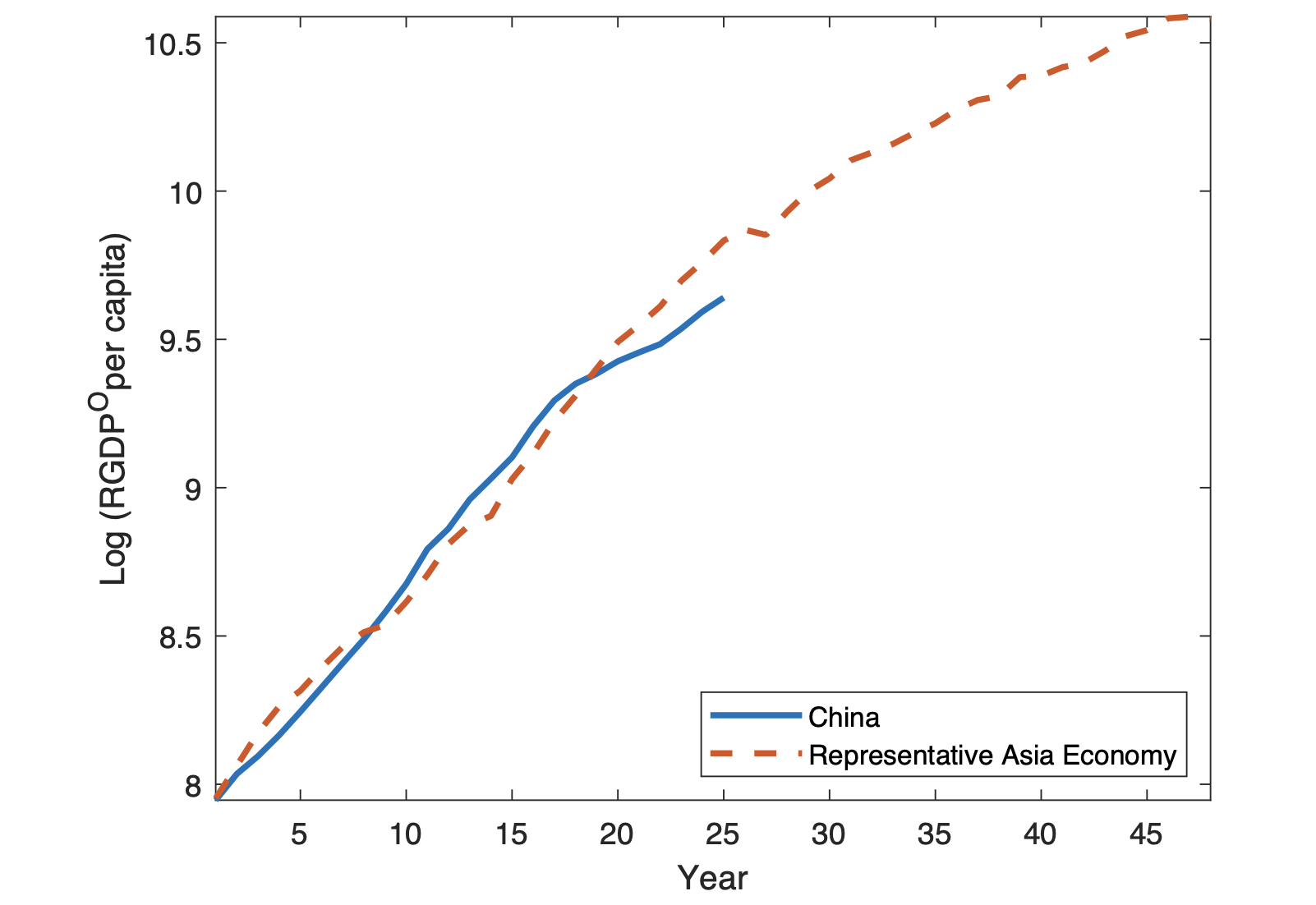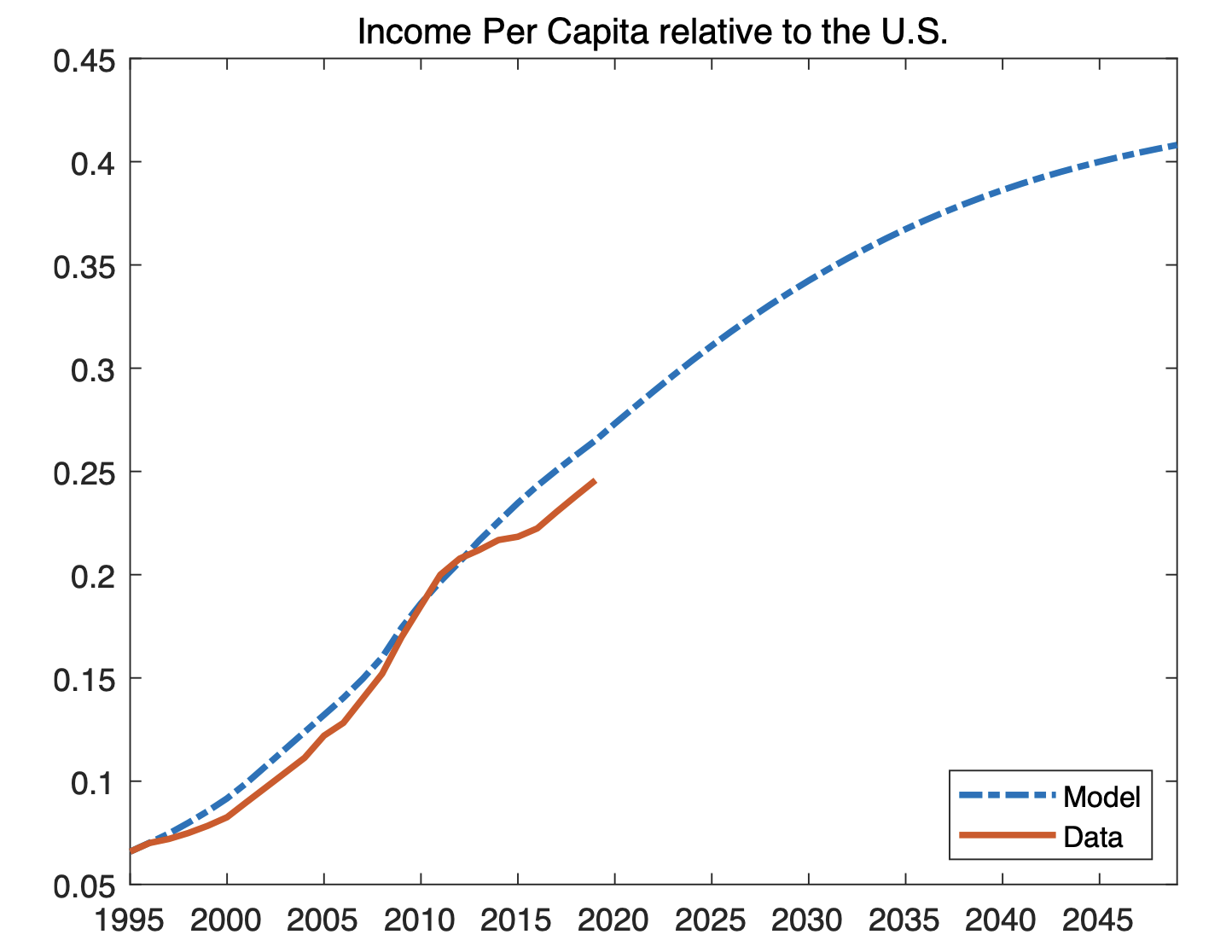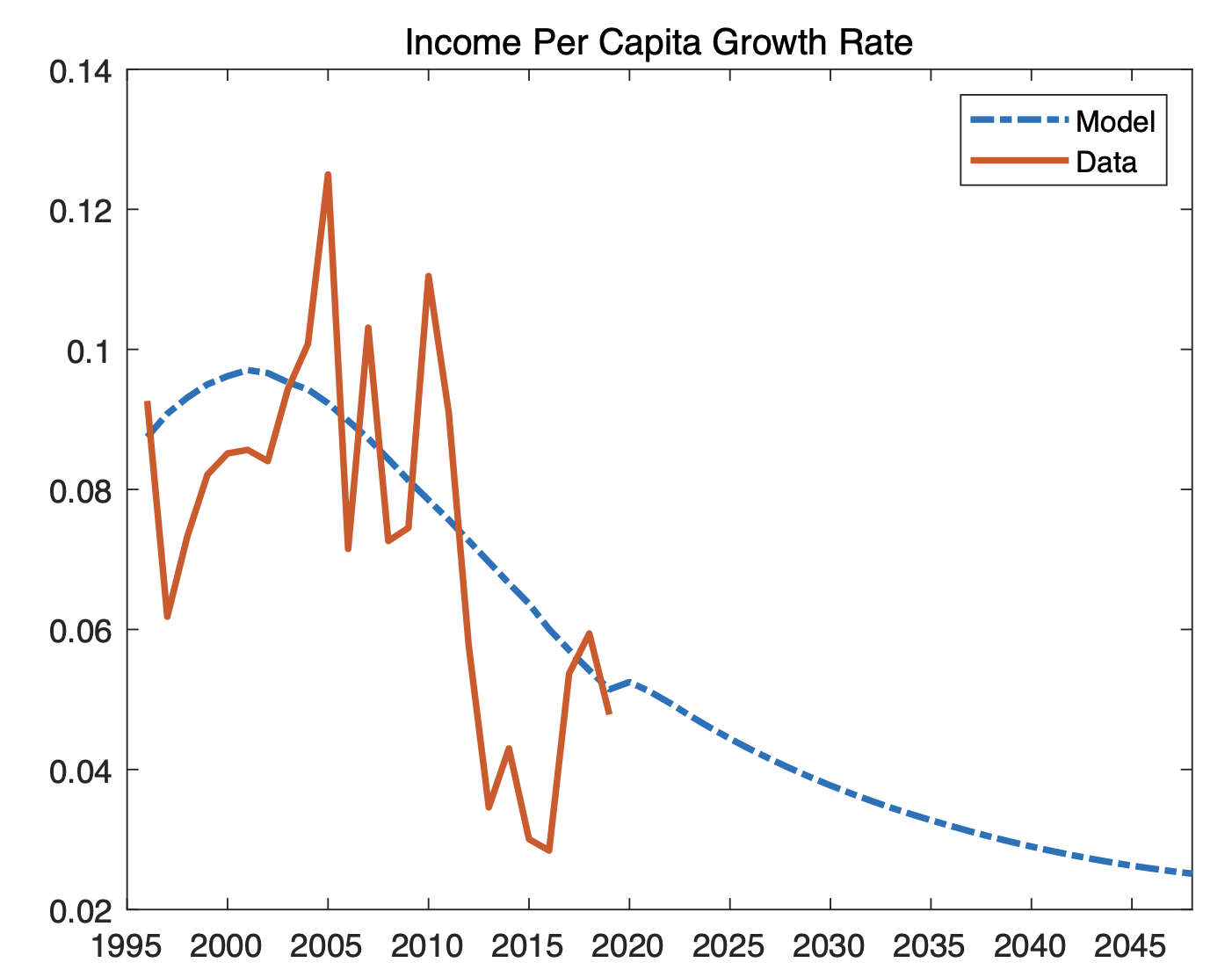Few events in global economic history have been as transformative as China’s recent economic growth. China's real per capita GDP, measured in Purchasing Power Parity (PPP)-adjusted real dollars, surged from 6.6% of the US per capita GDP level in 1995 (when China became a middle-income economy) to 25% in 2019 (the last year of data in Penn World Tables 10.0). Given China’s population, this fast growth has reshaped the world economy (see Naughton 2018 for an analytic narrative of China’s economy over the last several decades).
China’s growth motivates many questions. Was it exceptional in comparison with other East Asia growth miracles? How can we account for it? Are China’s economic policies a model to be followed by other emerging economies? And, perhaps most importantly, will it continue over time?
China in comparison to its East Asian peers
To answer these questions, in a recent paper (Fernández-Villaverde et al. 2023) we start by comparing China’s growth experience with that of Japan, Taiwan, South Korea, Hong Kong, and Singapore.
We do so by following these economies during the years when each of them get closest to China’s GDP per capita in 1995.
To clarify this idea, take the example of South Korea. This economy reached $2852 in 1972. Thus, we compare South Korea from 1972 to 1996 to China from 1995 to 2019. In that way, we aim to understand how each economy performed when the two economies were at roughly the same level of economic development.
Figure 1 plots the evolution of China’s output per capita against the output per capita of what we call the ‘representative Asian economy’, i.e. the average of South Korea, Taiwan, and Japan (we drop Hong Kong and Singapore from this mean since, as city-states, they might have their own peculiarities; nonetheless, the results are nearly identical if we include them as well). The result is striking. China has performed exactly as the representative Asian economy did when it was at the same level of economic development. If anything, China seems to be underperforming since the early 2010s.
Figure 1 China’s GDP per capita versus the representative East Asian economy’s GDP per capita
We can even strengthen the argument by noting that the world technology frontier was more advanced when China became a middle-income economy than when Japan, Taiwan, and South Korea were at the same stage. China had, therefore, more room to catch up and deliver faster growth. In other words, China’s growth is not exceptional per se (or the product of a particularly insightful combination of economic policies that could serve as a template for other economies) but for the size of China’s population.
Also, Figure 1 suggests a sharp prediction: if Japan, Taiwan, and South Korea’s economic growth slowed down after the first decades of high rates, there is a high probability that China would do the same. Our prediction is not new; Barro (2016) and Den Haan et al. (2013) have presented similar arguments.
A model of China’s development trajectory
This similarity in how the East Asia growth episodes unfolded raises the question of whether a common theoretical framework can offer a unified understanding of development across all these economies. To explore this idea, we postulate a minimalist Ramsey-Cass-Koopmans one-sector growth model augmented with a parsimonious Total Factot Productivity (TFP) catch-up process governed by three parameters that specify: (i) the initial TFP level, (ii) the asymptotic catch-up TFP bound relative to the US, and (iii) the speed of catch-up. We calibrate the model to conventional aggregate targets and to match the observed patterns of TFP growth. While we are agnostic about the specific mechanisms that may be driving TFP catch-up in China or the other growth miracles, our approach provides a simple and transparent evaluation of the growth process in these economies. Moreover, it allows us to predict China’s growth trajectory by extending the TFP process into the future.
Figure 2 plots China’s GDP per capita relative to the US in the model (dashed blue line) and the data (solid red line). We find that the model matches China’s income per capita growth from 1995 to 2019 surprisingly well. We emphasize surprisingly because the model is so simple; it does not include factors studied in the literature, including sectoral reallocation, financial market developments, industrial policies, foreign direct investment, or trade policies. We do not dismiss the importance of these or other factors. Rather, those factors may be contributing to the process of TFP catch-up.
Figure 2 China’s GDP per capita relative to the US
Figure 3 shows China’s GDP per capita growth rate in the model (dashed blue line) and the data (solid red line). Our minimalist growth model again matches the data very well, including the hump shape of growth (we do not have stochastic shocks and, therefore, cannot trace year-to-year fluctuations, just the time-varying trend). Our model can also match the evolution of investment (when we correct the official series as suggested by Chen et al. 2019) and the rate of return on capital.
Figure 3 China’s GDP per capita growth rates
Our main result is striking: neoclassical growth theory can account for China’s experience once we consider TFP catch-up.
This result is important because we can use the model to forecast the future of China’s economy. We use the model and the fitted TFP catch-up process to predict that China's relative per capita GDP level will asymptote to about 41% of the U.S. level around 2050, reflecting the substantial slowdown in China's observed TFP catch-up in recent years. Moreover, given China's forecasted demographics, which we take from the United Nations World Population Prospects, the model predicts that US output will grow faster (2.29%) than China's (2.27%) by 2043 and that, by 2088, the US economy will be larger than China's in PPP terms. Notice that, for our statement regarding 2043, there is very little demographic uncertainty left. Given current birth and death rates in China, around 85% of the people who will be alive in China in 2043 were already born by the end of 2022. Slowing TFP growth and a declining population suggest a far-from-booming Chinese economic future.
Model performance in other East Asian economies
We can validate our model externally by asking how well the same model accounts for the experiences of Japan, Korea, Taiwan, Hong Kong, and Singapore. We find that, with some economy-specific recalibration, the model also accounts for these growth episodes. This is a key validation for the model, particularly since the analysis of these other growth miracles covers different institutional and policy environments and many more years than that of China. The much longer period of study for these other growth miracles has important implications for China's future, as TFP growth continued to decline in all four economies over time. The present of Japan, Korea, Taiwan, Hong Kong, and Singapore is the future of China.
Notice that our approach ignores factors that might be of first-order importance. For example, we do not have a real estate sector that can implode (Zhou et al 2015, Rogoff 2021) or political risk (Szczerbowicz et al. 2019). We see this absence as a virtue, not a sin, of our model. We argue that China has been growing because it is accumulating capital and is catching up with the world's technological frontier. But China's technology catch-up is slowing considerably. This fact, combined with a declining population, means that China's growth can only slow down, perhaps significantly, regardless of what happens with the financial sector or political risk. In fact, the latter might be epiphenomenal manifestations of the tyranny of neoclassical growth: it is easy to grow when an economy is far from the frontier. It is much harder to grow as an economy gets closer to the frontier. However, our forecast may be too pessimistic if China implements new institutional reforms that improve economic efficiency to reverse its declining TFP catch-up rate.
References
Barro, R J (2016), “China’s growth prospects”, VoxEU.org, 4 February.
Chen, W, X Chen, C Hsieh and Z Song (2019), “A forensic examination of China’s national accounts,” Brookings Papers on Economic Activity 1.
Den Haan, W, F Caselli, J Chadha and A Armstrong (2015), “China’s growth slowdown: Likely persistence and effects”, VoxEU.org, 27 November.
Fernández-Villaverde, J, L Ohanian and W Yao (2023), “The Neoclassical Growth of China”, CEPR Discussion Paper 18193.
Naughton, B J (2018), The Chinese Economy: Adaptation and Growth, MIT Press, 2nd ed.
Rogoff, K (2021), “Can China’s outsized real estate sector amplify a Delta-induced slowdown?” VoxEU.org, 21 September.
Szczerbowicz, U, C Jardet, D Siena and A Berthou (2019), “The macroeconomic implications of a global trade war,” VoxEU.org, 8 February.
Zhou, L, Q Gu, W Xiong and H Fang (2015), “China’s housing boom”, VoxEU.org, 27 May.








